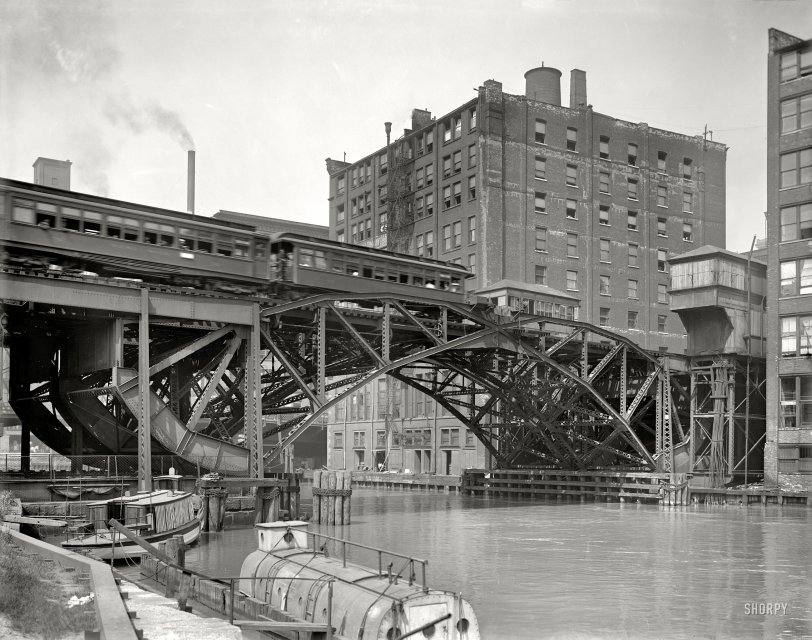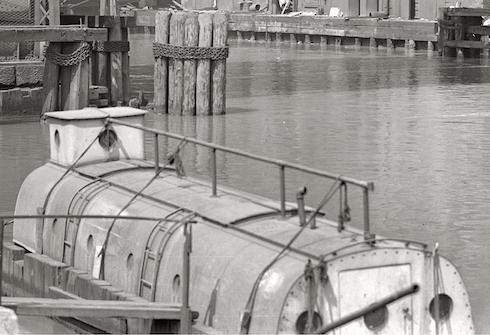


Framed or unframed, desk size to sofa size, printed by us in Arizona and Alabama since 2007. Explore now.
Shorpy is funded by you. Patreon contributors get an ad-free experience.
Learn more.

- Tough Guys
- Lost in Toyland
- And without gloves
- If I were a blindfolded time traveler
- Smoke Consumer Also Cooks
- Oh that stove!
- Possibly still there?
- What?!?
- $100 Reward
- Freeze Frame
- Texas Flyer wanted
- Just a Year Too Soon
- WWII -- Replacing men with women at the railroad crossing.
- Yes, Icing
- You kids drive me nuts!
- NOT An Easy Job
- I wonder
- Just add window boxes
- Icing Platform?
- Indiana Harbor Belt abides
- Freezing haze
- Corrections (for those who care)
- C&NW at Nelson
- Fallen Flags
- A dangerous job made worse
- Water Stop
- Passenger trains have right of way over freights?
- Coal
- Never ceases to amaze me.
- Still chuggin' (in model form)
Print Emporium
Jackknife Bridge: 1907

Chicago, Illinois, circa 1907. "Jackknife Bridge, Chicago River." Our second look at this riveting (and riveted) span. Glass negative by Hans Behm. View full size.
Great Lakes Lifeboat?
The rounded top and porthole cockpit of the boat in question appears akin to modern offshore lifeboats.

Fencing
It looks like they're using that newfangled chain link fencing - introduced to the US a mere 16 years ago.
A Steampunk Shrine
It should be!
As engineers sought a better solution to Chicago's bridge problem, the city entered its experimental phase. A jack-knife bridge that folded back on itself was built in 1891 but was deemed a failure. The first vertical lift bridge, with tall towers at either end controlling counterweights to lift a center span, was completed in 1894. And, in 1895, the Scherzer rolling lift bridge was developed in Chicago, opening at Van Buren Street.
But the bridge type most associated with the city is the trunnion bascule. Trunnion bascule bridges have leaves that rotate on a shaft, or trunnion, located on the shore. A complex system of counterweights, gears and electric motors, operated by a bridge tender, raise the leaves upwards and away from the center of the river. The first trunnion bascule bridge in the United States was completed in 1902 at Cortland Street, and it is still there today. Not only did the design prove effective, but it was copied around the world and became known as the Chicago-type bascule. Most of the bridges you see in Chicago now are of the bascule-type, but examples of the swing bridge, vertical lift and Scherzer lift still exist, though many are now inoperable.
Rivercamper
If Airstream made a boat in 1907, it'd probably look like that strange vessel at the bottom of the picture.
Rolling lift bridge
The Metropolitan West Side Elevated Railroad trains crossed the Chicago River just south of Jackson Boulevard on this example of a Scherzer Rolling Lift Bridge, one of at least ten crossing the main channel and the north and south branches of the Chicago River, designed by Chicago's Scherzer Rolling Bridge Co. The western terminus of the "Met" was in my hometown, Westchester, Illinois, a "planned" community developed by traction magnate Sam Insull, and, as part of the CTA, ran into Westchester until the mid-1950s. I vaguely recall the station on the north side of Canterbury between Balmoral and Westchester Boulevard, and the ground level crossing at Canterbury. The western terminus was moved to Forest Park, and is still the main westside "L", running in the median of the Congress Park Expressway (excuse me, Eisenhower Expressway!).
Odd boats!
The boat on the left reminds me of The African Queen, and the one on the right looks a bit like a Jules Verne submarine! What sort of uses is that riveted tubular craft designed for? Is there a name for the design?
Non-Submerging Submarine
I've seen some strange watercraft in Shorpy pictures, but none stranger or less obvious of its purpose than the one in the foreground -- what the heck is it? It reminds me of the Coney Island Submarine. Or possibly some kind of covered barge? It seems to have sliding panels on the top. Maybe someone's homemade houseboat?
























On Shorpy:
Today’s Top 5